A few weeks ago, I brought home some potted herbs from the grocery store, rosemary, cilantro, and sorrel. The late winter blues had set in, I was cooped up in the house recovery from a recent surgery, the herbs that I had overwintered were leggy and anemic looking from low levels of light. I desperately needed green and fresh herbs! You can’t blame a girl for longing for spring and wanting to freshen up her dinner plate.
Unfortunately, those innocent looking herbs would lead to my seedlings becoming infected with a massive colony of aphids. It’s something that I will fully take the blame for. Whether it was through a lack of inspection when I brought them home, a lack of quarantining, or simply a lack of me paying attention and inspecting the plants at the store, those few plants resulted in dozens and dozens of my seedlings becoming infected with hundreds, if not thousands of aphids.
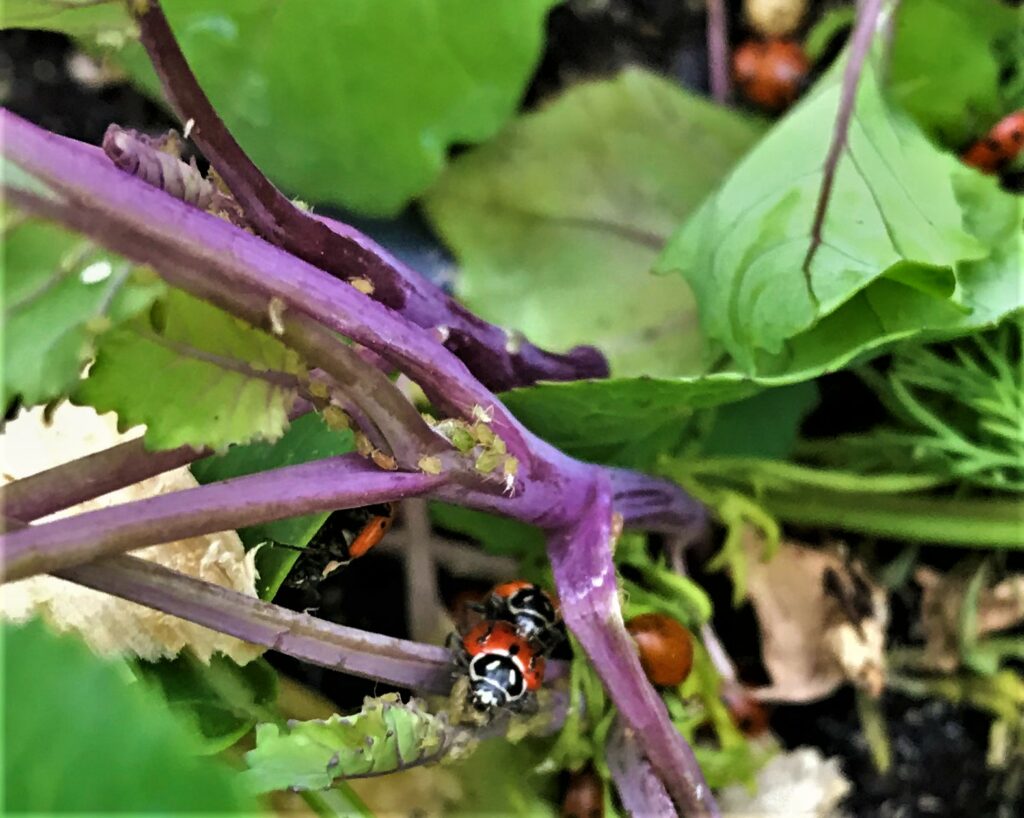
Aphids – a tiny little bug was giving me a huge headache. They were rapidly reproducing and munching away on my tender little seedlings.
I first noticed the aphids on the herbs when one evening I went to harvest fresh cilantro for dinner. I love the zingy combination of line and cilantro.
In the fall and winter, I like to keep potted herbs on the windowsill in my kitchen, it’s a southern facing window that gets good light exposure. During the late spring, summer, and early fall growing season we’re able to harvest fresh herbs from the garden. When I first noticed those little, light green bugs, I didn’t think about too much, I squished the bugs that I saw, gave the plants a quick rinse in the sink, and went about my life. A few days later I noticed that the number of aphids on the herbs continued to increase. A short time later I noticed that there were a few aphids on my cabbage and brussels sprout seedlings that were located in a different room.
Oh, heck no! This meant business. My potted herbs are one thing, my tender, little seedlings are something completely different.
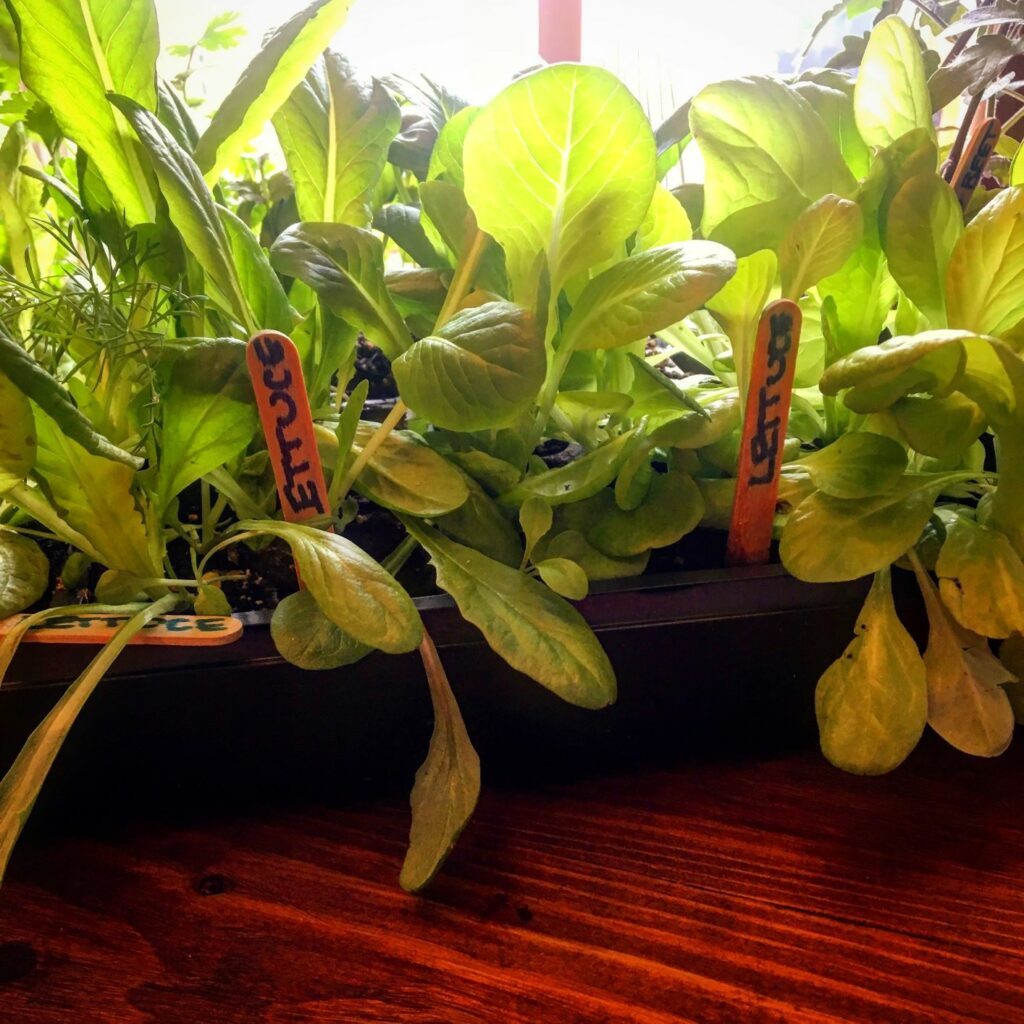
I carefully inspected all of the seedlings; the issue seemed to be confined to a few plants – mainly my tender cabbage and brussels sprouts. I took the same approach that I used with the herbs, squished the bugs that I saw, and tried to give the plants a gentle rinse.
Have you ever attempted to rinse off a full tray of seedlings in the sink? It doesn’t work well. Dirt all over, little actual rinsing of the plants. Basically, a huge an unproductive mess. The seedlings went back under the grow lights and I all but forgot about the aphids.
Around the same time that I noticed a sudden uptick (and by uptick I mean an explosion) of aphids on my herbs, I noticed that same happening to my seedlings. The aphids had migrated and multiple, they had spread and were feasting on most of my plants. The only plants that didn’t seem to be affected at this point was my tomato seedlings.

Out of frustration I chucked the herbs outside (we were experiencing temperature dips below freezing) and vowed to never bring home potted herbs without giving them a thorough inspection. I knew that the cold weather and freezing temperatures would kill the aphids, but also kill the herbs. At that point I didn’t care. I was about to enter damage control mode. I just wanted to rid myself of my uninvited guest that was feasting on my plants.
So what are aphids?
Aphids are a small soft-bodied insect that feed off plants. They use their sharp, piercing mouthparts to feed on plant sap and usually form large colonies on the undersides of leaves. They’re small, hang out on parts of the plants that you don’t regularly look at, and are easy to miss until you have a large colony of them. They reproduce rapidly and are often produce live offspring asexually without mating (Parthenogenic).
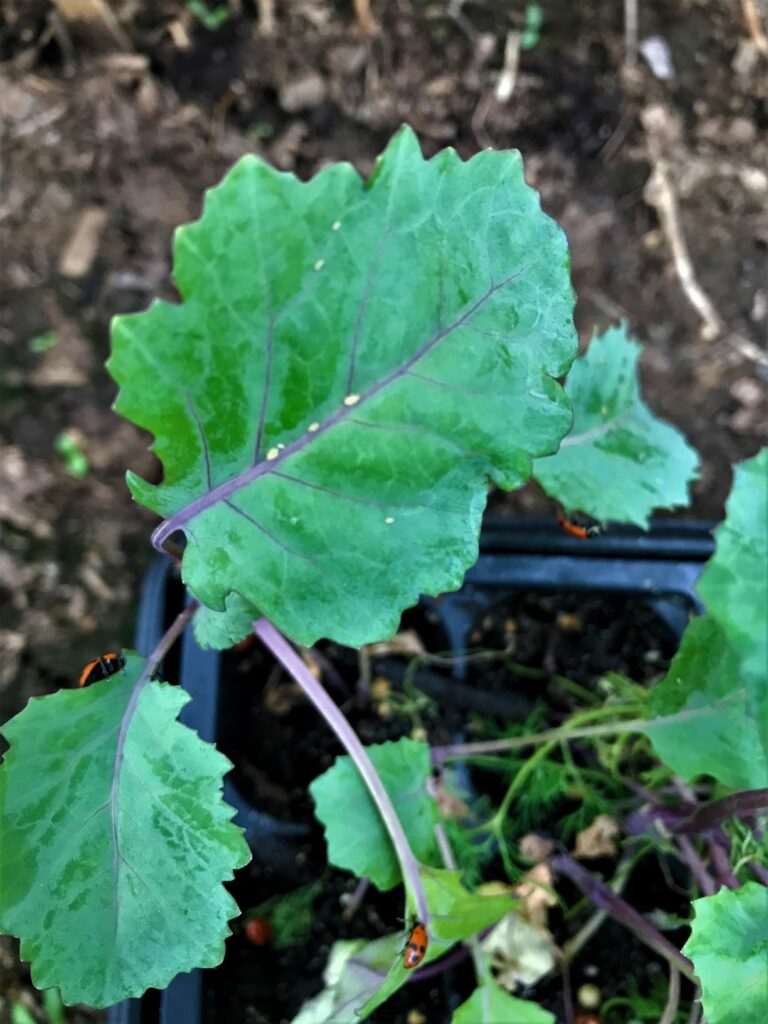
Let’s talk science for a second.
Parthenogenesis – this term means that it is a natural form of asexual reproduction. This means the development of an embryo from an unfertilized egg cell. This results in the growth and development of an embryo without the egg ever being fertilized.
So, what that really means is that Ms. Aphid, doesn’t need to be a Mrs. or a have a Mr. to make babies. Even if you have one, single (in every sense of the word), female you can end up with a huge aphid infestation.
The young offspring, which are called nymphs look like miniature versions of the adults. Even though I don’t like aphids, I don’t want aphids, they are still fascinating. The nymphs really are carbon copies of the parent. They can exist in large colonies and can cause extensive damage to your plants and can survive in almost any garden zone. Heavily-infested plants and leaves can end up wilting and turning yellow, leading to decreased plant vigor, malformed fruit, and even plant death in severe infestations.
If you have numerous small green bugs on your plants – unfortunately, you probably have aphids! No need to panic, we’ll talk about how we got rid of them and what you can do to rid yourself of them.
Adult aphids are tiny, they are under a ¼ inch, and can be very easy to miss unless you purposely and carefully inspect your plants. There are a variety of species and come in a wide range of colors, they can appear white, black, brown, grey, green, yellow, and pink. This garden pest has a pear-shaped body, long antenna, and most species have two short tubes, called cornicles, that project from their hind end.
In general aphids feed on a wide variety of plants, however certain species of aphids can be specific to certain plants. Aphids grow and reproduce very quickly; they mature in 7 – 10 days and are ready to produce live offspring through asexual reproduction. Most of the offspring will be female and each is capable of producing 40 – 60 live young. Less than a dozen aphids can produce hundreds to thousands of aphids on plant or in a single location in just a few short weeks.
It’s almost mind boggling – just a few, innocuous looking insects can multiple and produce thousands of nearly carbon copies of themselves in a few weeks.
Adult aphids are usually wingless, but most species can and will develop wings when populations become too numerous and overcrowded. When the amount and quality of food decreases the insects will set out and travel to other plants and locations to start a new colony.
Identifying Aphid Damage:
Adult and juvenile aphids feed on the plant juices. They attack the leaves, stems, buds, flowers, fruit, and depending on the species they can even attack the roots. Most aphids prefer to feast on succulent new growth and can cause significant damage to young and growing plants.
- Misshaped, curled, stunted, or yellowing leaves – check the undersides of leaves, this is where you’ll often find aphids hanging out.
- If you notice that the leaves and stems of your plants are covered with a sticky substance, check for the presence of aphids. This sticky substance is referred to as honeydew – it’s the waste product that the inspects produce. It’s a sugary liquid and it can actually attract other insects, such as ants, which will gather the substance for food.
- Aphids can cause flowers or fruit to become distorted, deformed, and damaged due to aphids feeding on flower buds or fruit.
- The appearance of sooty mold – this may be your first indication that there is an aphid infestation. This fungus can grow on the honeydew deposits that accumulate on the leaves and branches, turning them black. Once you remedy the aphid infestation the sooty mold will typically go away on its own.
How to Get Rid of Aphids:

There are several natural ways that can help you get rid of aphids. Early detection is key to reducing and completely eliminating the infestation. Before you bring home any new plants or seedling be sure to carefully inspect them, this includes the base, stem, leaves, underside of leaves, soil surface, and any buds. If something seems off or your suspect disease or some type of insect infestation pass on them and don’t bring them home. Weekly examination of plants in your home and garden will alert you to any early issues. In our summer vegetable garden, we like to do random spot checks of plants – we look for any disease, pests, or insect damage. It’s not possible to inspect every surface or every plant, but frequent spot checking will help alert you to any possible issues.
- Spray your infected plants with cold water – by spraying the leaves you can dislodge the aphids.
- Try dusting your plants with flour – the flour will coat the aphids, causing them to drop off the plant.
- Neem oil, insecticidal soaps, horticultural oils – be sure to follow the specific instructions.
- Wipe and spray your plants with a simple solution made of water and a few drops of dawn dish soap. Reapply the mildly soapy water every 2 – 3 days.
- Use natural enemies. Beneficial insects, such as ladybugs and lacewings can be used to help control and eliminate aphids. They eat large numbers of aphids and drastically reduce the number of pests that you have.
After trying to manually remove the aphids and our inconsistent approach to spraying our infected plants down with cold water we decided to take a different and more direct approach and use ladybugs. I decided to stop at a local greenhouse/garden center to see if they had any ladybugs for sale before ordering them online.
Yes! You can purchase ladybugs and other beneficial insects. Your local garden center might carry them, if not you can order them online. In the past we’ve purchased and ordered them from Amazon. Armed with a small container of 1500 ladybugs I headed home to work out my battle plan.
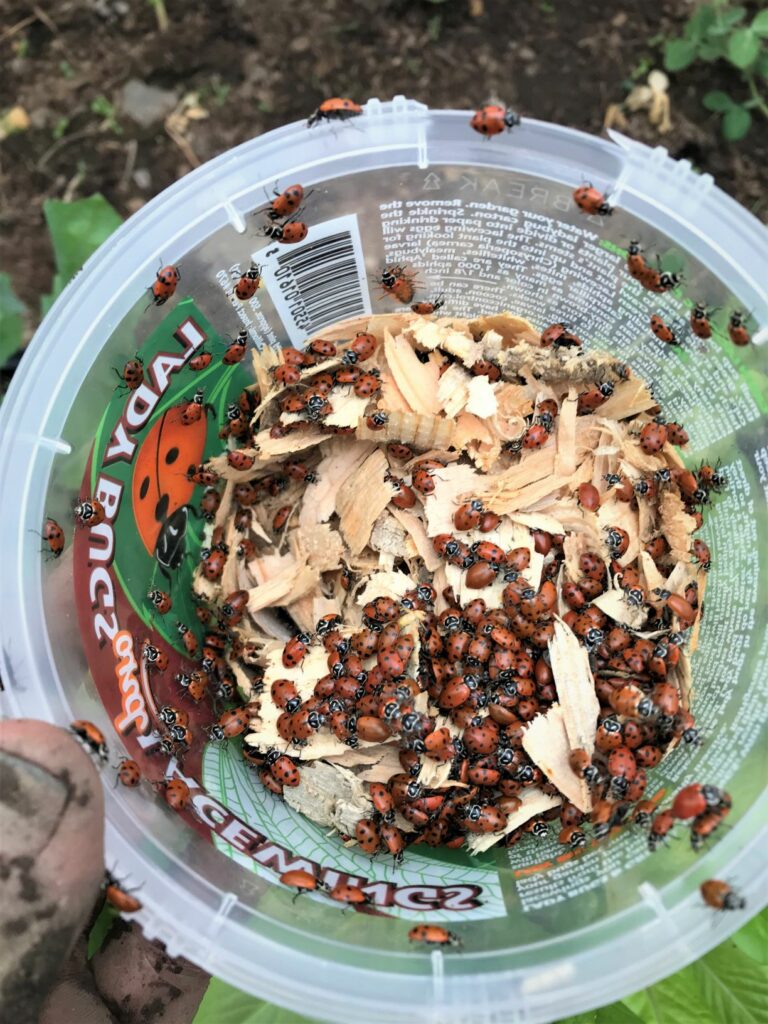
Why Use Ladybugs for Aphid Control?
Ladybugs love to eat aphids. Both the adults and larvae are predators and will consume other insects. In fact, each ladybug can consume up to 50 or 60 aphids per day. They are active predators and will seek out aphids and other inspects from dawn until dusk. An adult can eat more than 5000 aphids in its lifetime. Ladybugs will also eat a variety of other insects and larvae, including scales, mealy bugs, leaf hoppers, mites, and a variety of other soft-bodied insects. Between the ladybug’s appetite and reproductive capacity, they’re often able to rapidly clear out their prey.
In our zone 5 garden our days are starting to warm up and most nights are well above freezing. We have a small greenhouse that we built last year out of reclaimed windows. Here’s the thing about ladybugs, they are wild creatures. If you don’t keep them confined or if they don’t like their home, they will leave. You don’t want your newly purchased ladybugs flying off to parts unknown! You need to do everything possible to encouraging them to stay and start reproducing in your garden.
I knew that our small greenhouse would be the perfect place to release them. It has a higher humidity, warm during the day, and would prevent them from immediately flying away and leaving. Another option is to create a small tent out of fine mesh. Place you plants and the ladybugs in the tent and keep them confined to the area for a few days. Once lady bugs have eaten their way through the food source, they will actively look for other sources of food.
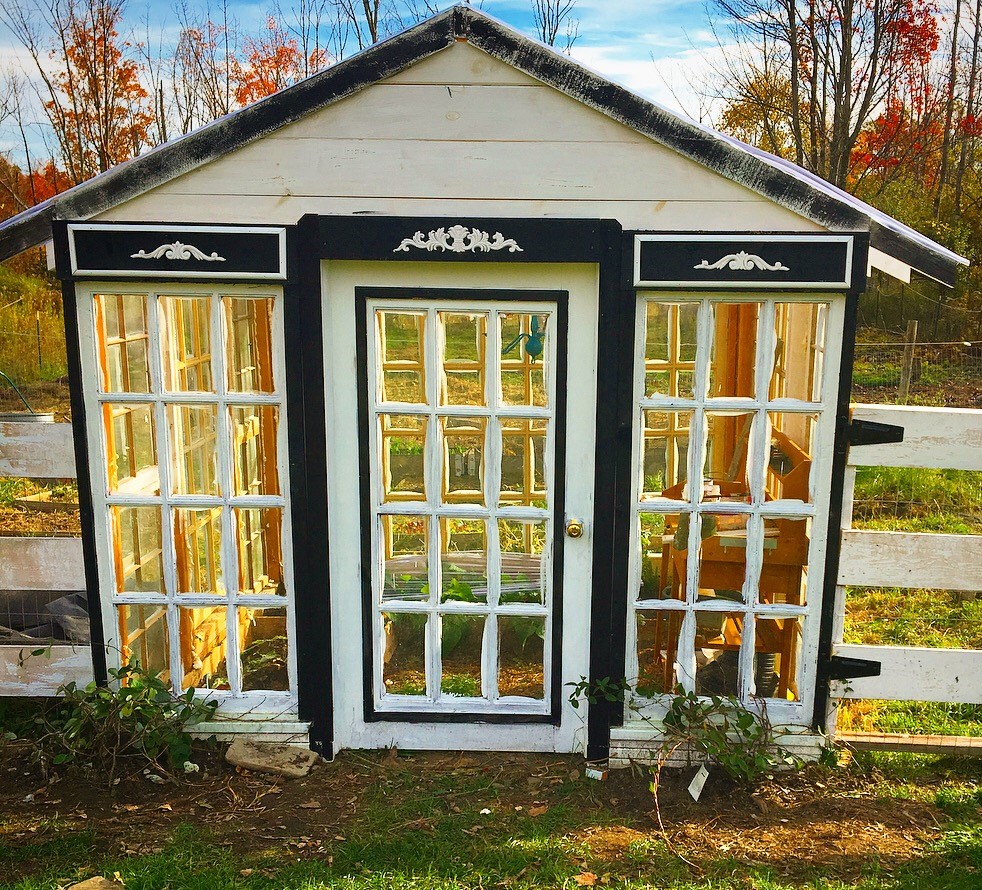
I checked the weather, made sure that we would have a warmer evening and I packed up and carried out all of our seedlings to the greenhouse. Gave the plants a quick drink from the watering can and released the ladybugs that evening.
It was spectacular! The sight of hundreds of ladybugs was awe inspiring! These ladies did not disappoint! Almost immediately they set out and covered all the seedlings. Team ladybug quickly getting to work eating and drinking.
When I returned the next morning, they were happily gorging themselves on the aphids. Within a few days almost all of the aphids were eliminated. It is simply amazing how much work the ladybugs did in a few days. My aphid problem was almost completely eliminated, all without the use of harmful chemicals or pesticides.
Tips for Releasing your Ladybugs
It’s important to release your ladybugs in the evening. You don’t want to release them during the heat of the day, or while the sun is shining. When you release them in the evening, they are more likely to stay in the location that you release them. Ladybugs will not fly at night and need a settling down period after releasing them. When you release your ladybugs, gently scatter and spread them so each ladybug can immediately find food. It also helps to spray down the area that you’re releasing them with water. This ensures that your ladybugs have water to drink.

Have you experienced issues with aphids or other insects? Have you tried any natural remedies or used beneficial insects?
Until next time…
Ashley

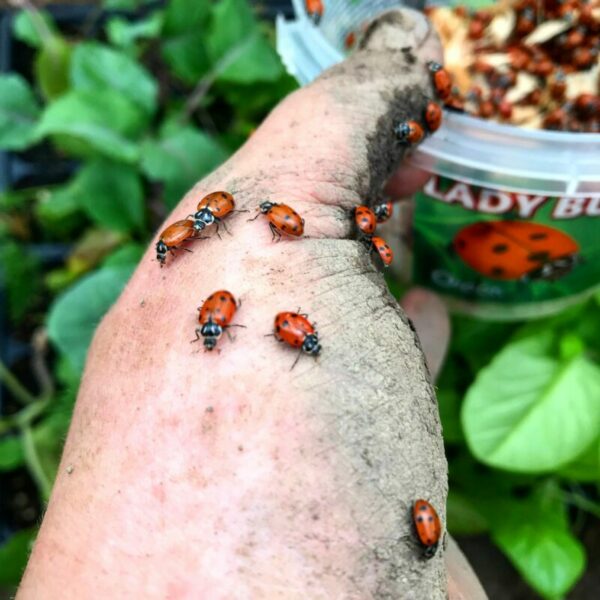
You forgot to add that ladybugs are known to bring good luck…the more the merrier!